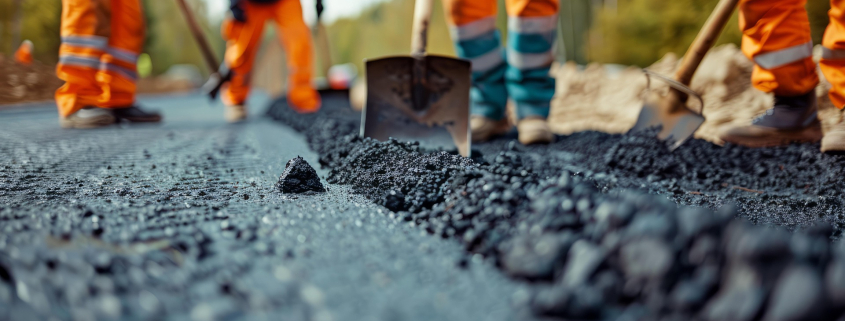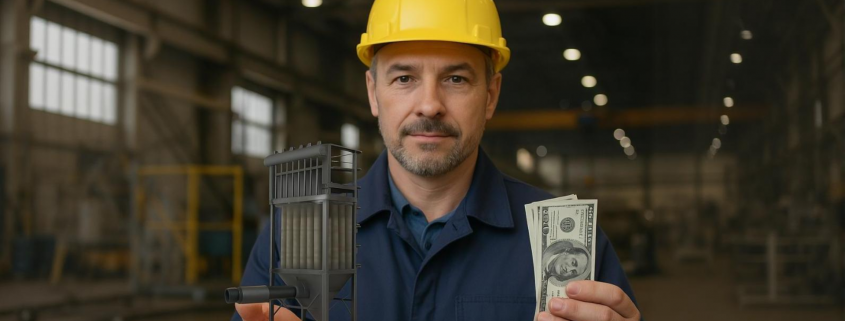
In the world of asphalt manufacturing, dust collection systems are essential equipment that protect workers, ensure clean operation, and help keep plants running efficiently and profitably.
Through the years, Baghouse.com has helped many asphalt plants design their systems, maintain, troubleshoot, and upgrade their systems. We have learned many good tips we would like to share with you in a series of three articles:
Asphalt Production & Dust Control (Part 1)
Asphalt Production & Baghouse Fines (Part 2)
Asphalt Production & Dust Collectors Design and Maintenance (Part 3)
Let’s first take a look at how asphalt is produced.
How Is Asphalt Made?

Asphalt is a black, sticky, and highly viscous liquid derived from crude oil.
Asphalt is a black, sticky, and highly viscous liquid derived from crude oil. It acts as a binding agent when mixed with aggregate materials like stone, gravel, or sand. When combined, they form what we commonly refer to as asphalt cement or simply asphalt.
Historically, natural deposits of asphalt were used, but today, virtually all asphalt used for commercial and industrial purposes comes from petroleum refining. The final product is a strong, durable paving material used primarily in road construction. In fact, asphalt is the most widely used material for building roads in the United States — and the country is home to around 3,600 hot mix asphalt plants, producing over 400 million metric tons of asphalt paving material annually.
These plants fall into two major categories: batch plants and drum mix plants.

The asphalt production process begins with the cold aggregate supply system (1), where different sizes of aggregates are fed into the plant. These materials are then transferred to the drum dryer (2), where they are heated by the coal burner (3). Fuel is delivered by the coal feeder (4). During the drying phase, dust generated is captured by the cyclone dust collector (5) and the finer particles are filtered out by the baghouse dust collector (6). The hot aggregates are lifted by the hot aggregate elevator (7) to the top of the tower, where they are sorted by size using the vibrating screen (8). The filler supply system (9) adds mineral fines, and everything is then weighed and blended in the weighing and mixing system (10). The final hot mix asphalt is stored in asphalt storage (11) and the bitumen supply system (12) provides the binder essential for forming the asphalt mix.
Take a look at how an Asphalt Plant works in the following video:
Where Does Dust Collection Come Into the Picture?
To understand where dust collection fits into the asphalt manufacturing process, it helps to walk through how a plant operates.
In drum mix plants, cold aggregates that have already been sized are fed into a rotating drum. Inside, the aggregates are dried, and at the end of the drum, asphalt cement is injected to coat them in a continuous process.
In batch plants, the aggregates are first dried in a rotary dryer, then screened into different sizes and stored in bins. These materials are then fed, batch by batch, into a pugmill mixer, where asphalt cement is added and mixed with the hot aggregate.
Both systems generate a considerable amount of dust during the drying and mixing phases — and that’s where dust collection systems become crucial.
A typical setup includes a drying drum connected via ductwork to a baghouse that captures airborne dust particles generated during the drying and mixing stages. Most systems also include cyclones to collect the larger, heavier particles before they reach the filters.
What Are Baghouse Fines?

Far from being useless, baghouse fines are sometimes reused in the asphalt mix itself as mineral fillers, depending on the mix design and application.
The fine particles collected by baghouses are called baghouse fines, or BFs. These are ultra-fine dust particles removed from the exhaust gas stream. Far from being useless, BFs are sometimes reused in the asphalt mix itself as mineral fillers, depending on the mix design and application.
In the United States alone, asphalt plants generate an estimated 6 to 8 million tons of baghouse fines annually. Proper handling and collection of these fines is not only critical for environmental compliance but also provides an opportunity for recycling and cost savings.
Why Are Collectors So Important?
About 40 to 50 percent of asphalt plants use baghouse systems for dust control. They are used to:
- ✧ Prevent fine particles from clogging downstream equipment
- ✧ Protect workers and the environment from harmful emissions
- ✧ Maintain proper airflow and temperature balance in the drying process
- ✧ Allow for the reuse of valuable fines in the mix
Without a reliable collector, dust can accumulate rapidly inside the plant, leading to unnecessary wear on machinery, unplanned shutdowns, and even fire hazards. And when an asphalt plant experiences downtime, every minute lost translates to significant revenue loss — especially on tightly scheduled road work projects.
A Team That Helps Asphalt Plants Stay Clean and Productive
Baghouse.com has supported many asphalt plants across North America, helping operators troubleshoot, repair, and upgrade their dust collection systems. From replacing worn-out aramid filters, upgrading to pleated elements for better airflow, to retrofitting baghouses for improved cleaning performance — we’ve seen it all.
Our team of engineers and field technicians has worked hand-in-hand with hot mix asphalt plants across the country, and we understand the challenges asphalt producers face: high temperatures, tight spaces, short timelines, and the constant need to reduce downtime and stay compliant with environmental regulations.
So whether you’re planning your next plant move or struggling with pressure drop or bag failure, we’re here to help you keep your operation clean, safe, and productive.
Stay tuned for the second and third parts of this series of articles!
Need help with your asphalt plant’s dust collection system? Contact us today at Baghouse.com — because your uptime depends on it.
Images Credit:
By Unknown author – http://www.asphaltplant.cn direct link, CC BY 1.0, https://commons.wikimedia.org/w/index.php?curid=36614371
By Trougnouf (Benoit Brummer) – Own work, CC BY 4.0, https://commons.wikimedia.org/w/index.php?curid=77336217
By Lord Mountbatten – Own work, CC BY-SA 3.0, https://commons.wikimedia.org/w/index.php?curid=23036022






